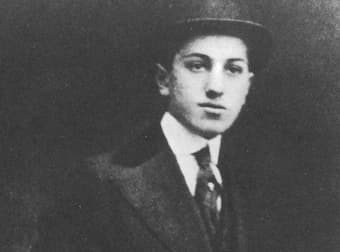
Young George Gershwin
The great American composer, pianist and conductor George Gershwin was born in Brooklyn, NY, on 26 September 1898. Son of poor Jewish immigrants, his parents Moshe Gershovitz and Rose Bruskin emigrated from the St. Petersburg region in Russia. They settled on New York’s Lower East Side, and by 1906 they had added three boys and a girl to the family. Young George quickly understood that he had a natural gift for writing fluent and compelling melodies. He carried a tune book wherever he went, and started to write down his numerous melodic inspirations. He also realized, however, that he needed some help with harmony, counterpoint and orchestration. As such he engaged the Hungarian composer and violinist Edward Kileny, who had immigrated to the United States in 1908. Kileny established a private music studio in New York City, and Gershwin faithfully went for weekly lessons over a period of almost 5 years.
George Gershwin: La-La-Lucille!: Nobody But You (Julie Hill, soprano; Craig Bohmler, piano)
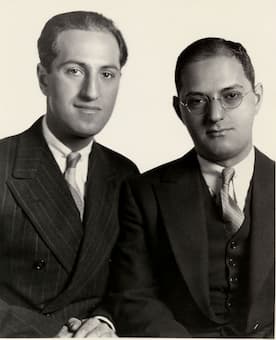
George and Ira Gershwin
At the age of 15, the Tin Pan Alley music-publishing firm of Jerome H. Remick & Co. hired Gershwin as a song plugger. Essentially, he was engaged as a salesman who promoted the firm’s songs by playing and singing them for performers. It was an environment where success was defined by the for-profit strategies of hit songs. Gershwin was always ambitious in his artistic dreams and in his quest for financial reward. Scholars have suggested, “Gershwin’s strategies for wealth, fame, and artistic achievement were all part of the same ambition to write great music that would reach large audiences. Musical excellence was a market opportunity; melody propelled by original, sophisticated music would triumph as art and as product.” In 1918, Gershwin signed a contract with Thomas B. Harms Music Publishing Company, a firm that would combine with the English firm of Chappell, Inc. to publish over 90 percent of all Broadway songs.
George Gershwin: Swanee (Kim Criswell, mezzo-soprano; Ambrosian Chorus; London Sinfonietta; John McGlinn, cond.)
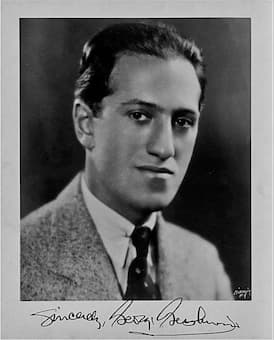
George Gershwin, 1935
Gershwin’s contract with Harms was a win-win situation. The publisher would receive exclusive ownership of Gershwin’s music and of any collaborating lyricist. Gershwin was allowed to compose for any Broadway production as long as the music would be published exclusively by Harms. In exchange, Harms promised to publish any and all the works created by the composer. Gershwin also received an initial royalty of three cents per copy for each piece of sheet music sold, and he was given a weekly salary of 35 dollars. His first megahit “Swanee,” with lyrics by Irving Caesar, sold more than 2 million recordings and 1 million copies of sheet music. Nonchalantly, Gershwin claimed to have written that song in “about an hour,” on a bus ride. From then on, there was no looking back and Gershwin churned out hits with incredible speed, sometimes up to 6 songs a day. Gershwin’s Broadway breakthrough, with lyrics by his brother Ira, came in December 1924. The production of Lady, Be Good! starred Fred and Adele Astaire and included the songs “Fascinating Rhythm” and “Oh, lady, be good!” both of which became standards of the American song repertory.
George Gershwin: Lady Be Good! “Fascinating Rhythm” (Renée Fleming, soprano; Dresden Staatskapelle; Christian Thielemann, cond.)
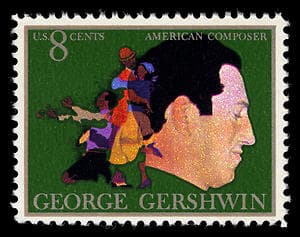
George Gershwin USPS stamp
Roughly one year earlier, on 1 November 1923, an unusual voice recital took place in New York’s Aeolian Hall. It featured the mezzo-soprano Eva Gauthier in an eclectic program with pieces ranging from Purcell and Bellini to Schoenberg, Hindemith, and Bartók. In addition, the recital also included a set of Broadway and Tin Pan Alley numbers written by Kern, Gershwin, Berlin, and Donaldson. George Gershwin was the pianist for the American set, and music critics hotly debated the introduction of “jazz songs into a classical program.”
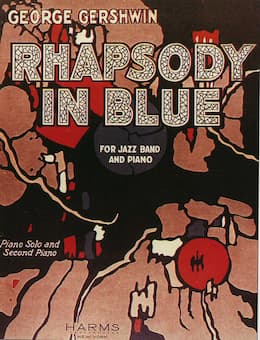
Rhapsody in Blue
For the longest time, as Gershwin reflected later in life, “I had wanted to work at big compositions.” His first classical piece was a lullaby for string quartet in 1919, and he followed that up with a brief opera called Blue Monday Blues. Opening the second act of “George White’s Scandals” of 1922, the songs failed to strike a chord and it was withdrawn after its first Broadway performance. Within a couple of years, Gershwin would, in the words of Irving Berlin, become “the only songwriter I know who developed into a composer.” Billed as “An Experiment in Modern Music,” the Rhapsody in Blue anchored Gershwin’s name into the history book by becoming the man “who brought jazz music into the concert hall.”
For more of the best in classical music, sign up to our E-Newsletter
Georg Gershwin: Rhapsody in Blue

You didn’t even mention, much less acknowledge, Gershwin’s masterpieces other that Rhapsody in Blue. What about Concerto in F, arguably the greatest of all American piano concertos & surely a world-class composition–or An American in Paris, or 2nd Rhapspdy, or Cuban Overture–or the most egregious of your omissions, the opera Porgy & Bess! Gershwin arguably IS the greatest American composer, but you don’t lead the unknowing to listen to his great works beyond Rhapsody in Blue!